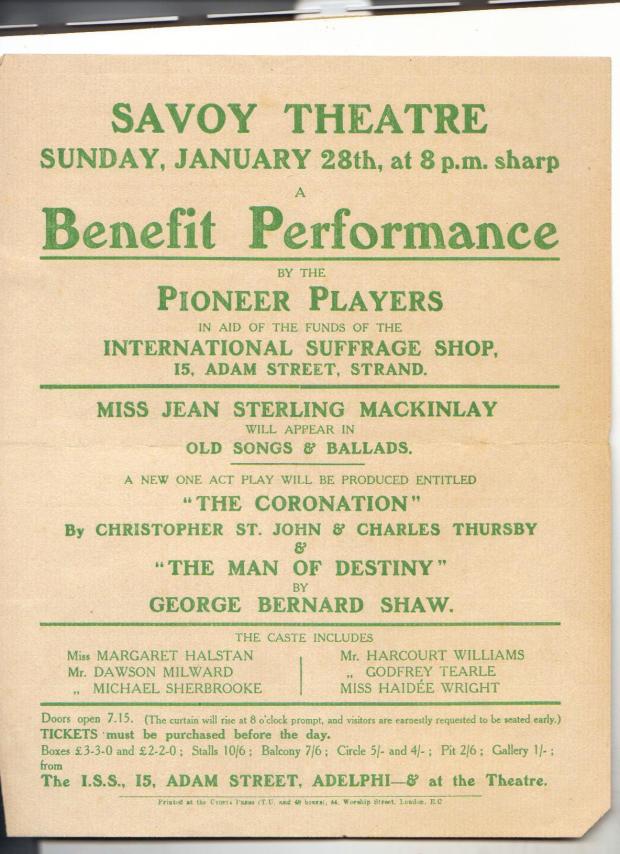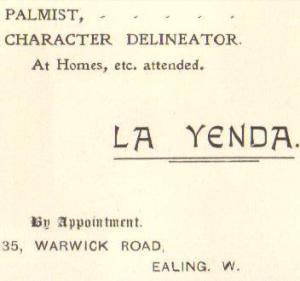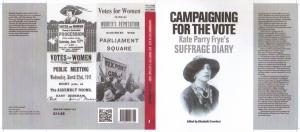Posts Tagged edith craig
Kate Frye’s Suffrage Diary: Palmist At The Women’s Freedom League Bazaar
Posted by womanandhersphere in Kate Frye's suffrage diary on December 10, 2012
 By 1909 Kate Frye was keenly involved – as a volunteer – in the women’s suffrage campaign. Although she belonged to the constitutional London Society for Women’s Suffrage she was happy to give her services to other, more militant, suffrage societies – such as the Women’s Freedom League.
By 1909 Kate Frye was keenly involved – as a volunteer – in the women’s suffrage campaign. Although she belonged to the constitutional London Society for Women’s Suffrage she was happy to give her services to other, more militant, suffrage societies – such as the Women’s Freedom League.
Dramatis Personae for these entries
Marie Lawson (1881-1975) was a leading member of the WFL. An effective businesswoman, in 1909 she formed the Minerva Publishing Co. to produce the WFL’s weekly paper, The Vote.
May Whitty (1865-1948) and Ben Webster (1864-1947) were a well-established theatrical couple. Kate had toured with May Whitty in a production of J.M. Barrie’s Quality Street in 1903.
Ellen Terry (1847-1928) the leading Shakesperean actress of her age.
Edith Craig (1869-1947) theatre director, producer, costume designer, and a very active member of the Actresses’ Franchise League. She staged a number of spectacles for suffrage societies, working particularly closely with the Suffrage Atelier and the Women’s Freedom League. In January 1912 Kate appeared in Edith Craig’s production of The Coronation.
Lena Ashwell (1862-1957) actress, manager of the Kingsway Theatre, a vice-president of the Actresses’ Franchise League and a tax resister.
Thursday April 15th 1909 [The Plat, Bourne End]
I went up to London at 9.50 all in my best. Went to Smiths to leave the books – then straight from Praed St to St James Park by train and to the Caxton Hall for the 1st day of the Women’s Freedom League Bazaar. Got there about 11.30 – everything in an uproar, of course. I had to find out who was in authority over me and where I was to go to do my Palmistry. I had to find a Miss Marie Lawson first and then was taken to a lady who had charge of my department and she arranged where I was to go. A most miserable place it seemed – in a gallery overlooking the refreshment room. I meant to have gone out to have a meal first – but it all took me so long running about getting an extra chair etc that I should have missed the opening. Then another Palmist hurried up – the real thing who donned a red robe. I was jealous. Madame Yenda.
We got on very well, however, and exchanged cards (I have had some printed) it was all about as funny as anything I have ever done and I have had some experiences.
Then I went back to the main room which was beginning to get thronged and stifling from the smell of flash- light photographs. I discovered Miss May Whitty and Mr Ben Webster and chatted to them while we waited for Miss Ellen Terry who was half an hour late. Miss Whitty was awfully nice and I quite enjoyed meeting her again. Ellen Terry looked glorious in 15th century costume and was very gay and larkish. Her daughter Edith Craig was there to look after and prompt her – and ‘mother’ her – what a mother to have had. I expect she had to pay for it. She is a sweet-looking woman with a most clever face – only a tiny shade of her Mother in it but Ellen Terry took the shine out of everyone – what a face to be sure. When she went round the stalls I went to the Balcony and for a little time Madame Yenda and I tried to work up there together but it was impossible. All my clients had to disturb her as they walked to and fro so at last I came out to find 3 more Palmists waiting and nowhere for them to work. One, a real professional, was very cross especially at the small fee being charged and I don’t think she could have been there long. Two other girls, looking real amateurs, were also there. So I sat a while at a table outside and told a few but it wasn’t very satisfactory and at 2 o’clock I went out for some lunch leaving the four others there. I went into a Lyons place in Victoria Street and then went back a little before 3 o’clock meaning to have a look round the Bazaar but I was pounced on to begin again and I was alone at it all the afternoon from 3 till 5.45 up in the gallery. I was left at it with sometimes just a few minutes in between but must have told 40 hands I should say. I did about 7 or 8 before 2 o’clock. We were only supposed to give 10 minutes at the outside but I could not quite limit myself and sometimes, when there wasn’t a rush, I had long talks with the people. It was very interesting and on the whole I think I was successful. Train to Praed St and to Smiths for the books and home by the 6.45.
Friday April 16th 1909 [The Plat, Bourne End]
I went straight to Caxton Hall by train from Praed St to St James’s Park – left some flowers at the flower stall. Mother had packed up some lovely bunches for me. Then I went up to the l[ondon] S[ociety] for W[omen’s] S[uffrage] office on business connected with the Demonstration – then back to the Caxton Hall for the opening of the Green White and Gold Fair on the second day. Miss Lena Ashwell was punctual 12 o’clock and she looked delicious and did it all so nicely. Madame Yenda was there but no other Palmists. My chatty friend, who greeted me rapturously, helped fix up the gallery a much nicer place – but clients did not come very early -they were all following Lena Ashwell – so I had 1/- from Madame Yenda myself. I think she was clever but, of course, I am rather a hard critic at it. She told me a great many things I know to be absolutely true and she gave me some good advice especially about morbid introspective thoughts and I think she is quite right. I do over worry. I am to beware of scandal which is all round me just now. She predicts a broken engagement, a rich alliance and always heaps of money. I should have immense artistic success in my profession if only I had more confidence in myself and if only I had some favourable influence (a sort of back patter, I take it) to help me but such an influence is far away. I shall never live a calm uneventful existence. I shall always spend so much of myself with and for others. I am rather glad of that. I was just beginning to tell her her hand but I wouldn’t let her pay as she told me she was very poor and I could see it when some clients came for us both and we both had to start our work.
I didn’t feel a bit inclined for work at first but got into it and had wonderful success. Kept on till 2 o’clock – went to the Army and Navy Stores then and had some fish for lunch – then back – saw the ‘Prison Cell’ for 5 and was very interested – then started work at 2.45 and never moved off my chair till 6.15. I did have an afternoon of it. Madame Yenda had gone and I was alone in my glory. I must have had quite another 40 people if not more and they were waiting in line to come in to me. I seem to delight some of the people and one or two said I quite made them believe in Palmistry. One old lady came back for another shill’oth [shilling’s worth] as I had been so good with her past and present she wanted her future. I must have been very clairvoyant as I told the people extraordinary things sometimes and they said I was ‘true’. Of course one or two I could not make much headway with but that must always be so.
Where I found I had missed my train I wanted to go on but my chatty friend was really awfully decent and would not hear of it. She said if I would tell one man who had been waiting ever so long that was all I must do and she would send the others away. There were about 18 waiting and she did – rather to my relief. I felt ‘done’
Campaigning for the Vote: Kate Parry Frye’s Suffrage Diary edited by Elizabeth Crawford
For a full description of the book click here
Wrap-around paper covers, 226 pp, over 70 illustrations, all drawn from Kate Frye’s personal archive.
ISBN 978 1903427 75 0
NOW, ALAS, OUT OF PRINT.
KATE FRYE’S DIARIES AND ASSOCIATED PAPERS ARE NOW HELD BY ROYAL HOLLOWA COLLEGE ARCHIVE
You can listen here to a talk I gave in the House of Commons – ‘Campaigning for the Vote: From MP’s Daughter to Suffrage Organiser: the diary of Kate Parry Frye’.
Copyright






